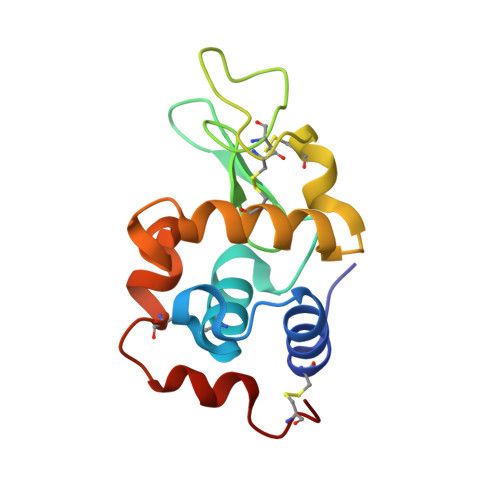Protein recognition of macrocycles: binding of anti-HIV metallocyclams to lysozyme
Hunter, T.M., McNae, I.W., Liang, X., Bella, J., Parsons, S., Walkinshaw, M.D., Sadler, P.J.(2005) Proc Natl Acad Sci U S A 102: 2288-2292
- PubMed: 15701702
- DOI: https://doi.org/10.1073/pnas.0407595102
- Primary Citation of Related Structures:
1YIK, 1YIL - PubMed Abstract:
The macrocyclic antiviral drug xylyl-bicyclam blocks entry of HIV into cells by targeting the CXCR4 coreceptor, a seven-helix transmembrane G-protein-coupled receptor. Its affinity for CXCR4 is enhanced by binding to Cu2+, Ni2+, or Zn2+. Metallocyclams have a rich configurational chemistry and proteins may bind selectively to specific metallocyclam configurations. Our studies of lysozyme reveal structural details of protein-metallocyclam interactions that are important for receptor recognition. Solution NMR studies show that Cu-cyclam interacts with specific tryptophan residues of lysozyme (Trp-62, Trp-63, and Trp-123). Two major binding sites for both Cu-cyclam and Cu2-xylyl-bicyclam were detected by x-ray crystallography. In the first site, Cu2+ in one cyclam ring of Cu2-xylyl-bicyclam adopts a trans configuration and is coordinated to a carboxylate oxygen of Asp-101, whereas for Cu-cyclam two ring NH groups form H bonds to the carboxylate oxygens of Asp-101, stabilizing an unusual cis (folded) cyclam configuration. For both complexes in this site, a cyclam ring is sandwiched between the indole side chains of two tryptophan residues (Trp-62 and Trp-63). In the second site, a trans cyclam ring is stacked on Trp-123 and H bonded to the backbone carbonyl of Gly-117. We show that there is a pocket in a model of the human CXCR4 coreceptor in which trans and cis configurations of metallobicyclam can bind by direct metal coordination to carboxylate side chains, cyclam-NH...carboxylate H bonding, together with hydrophobic interactions with tryptophan residues. These studies provide a structural basis for the design of macrocycles that bind stereospecifically to G-coupled and other protein receptors.
Organizational Affiliation:
School of Chemistry, University of Edinburgh, West Mains Road, Edinburgh EH9 3JJ, United Kingdom.

















